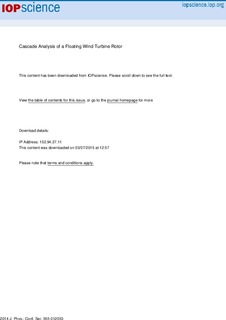| dc.contributor.author | Eliassen, Lene | |
| dc.contributor.author | Jakobsen, Jasna B. | |
| dc.contributor.author | Knauer, Andreas | |
| dc.contributor.author | Nielsen, Finn Gunnar | |
| dc.date.accessioned | 2015-07-03T13:12:22Z | |
| dc.date.available | 2015-07-03T13:12:22Z | |
| dc.date.issued | 2014 | |
| dc.identifier.citation | Eliassen, L.; Jakobsen, J.B., Knauer, A. & Nielsen, F.G. (2014) Cascade analysis of a floating wind turbine rotor. Journal of Physics, Conference Series 555(1) | nb_NO |
| dc.identifier.issn | 1742-6596 | |
| dc.identifier.uri | http://hdl.handle.net/11250/286503 | |
| dc.description | http://iopscience.iop.org/1742-6596/555/1/012053 | nb_NO |
| dc.description.abstract | Mounting a wind turbine on a floating foundation introduces more complexity to the aerodynamic loading. The floater motion contains a wide range of frequencies. To study some of the basic dynamic load effect on the blades due to these motions, a two-dimensional cascade approach, combined with a potential vortex method, is used. This is an alternative method to study the aeroelastic behavior of wind turbines that is different from the traditional blade element momentum method. The analysis tool demands little computational power relative to a full three dimensional vortex method, and can handle unsteady flows.
When using the cascade plane, a "cut" is made at a section of the wind turbine blade. The flow is viewed parallel to the blade axis at this cut. The cascade model is commonly used for analysis of turbo machineries. Due to the simplicity of the code it requires little computational resources, however it has limitations in its validity. It can only handle two-dimensional potential flow, i.e. including neither three-dimensional effects, such as the tip loss effect, nor boundary layers and stall effects are modeled. The computational tool can however be valuable in the overall analysis of floating wind turbines, and evaluation of the rotor control system.
A check of the validity of the vortex panel code using an airfoil profile is performed, comparing the variation of the lift force, to the theoretically derived Wagner function. To analyse the floating wind turbine, a floating structure with hub height 90 m is chosen. An axial motion of the rotor is considered. | nb_NO |
| dc.language.iso | eng | nb_NO |
| dc.rights | Navngivelse 3.0 Norge | * |
| dc.rights.uri | http://creativecommons.org/licenses/by/3.0/no/ | * |
| dc.subject | fluid dynamics | nb_NO |
| dc.subject | aerodynamics | nb_NO |
| dc.subject | elektronikk | nb_NO |
| dc.subject | wind turbines | nb_NO |
| dc.subject | vindturbiner | nb_NO |
| dc.subject | væskedynamikk | nb_NO |
| dc.title | Cascade analysis of a floating wind turbine rotor | nb_NO |
| dc.type | Journal article | nb_NO |
| dc.type | Peer reviewed | nb_NO |
| dc.subject.nsi | VDP::Mathematics and natural science: 400::Physics: 430::Electronics: 435 | nb_NO |
| dc.source.volume | 555 | nb_NO |
| dc.source.journal | Journal of Physics: Conference Series (JPCS) | nb_NO |
| dc.identifier.doi | 10.1088/1742-6596/555/1/012053 | |

